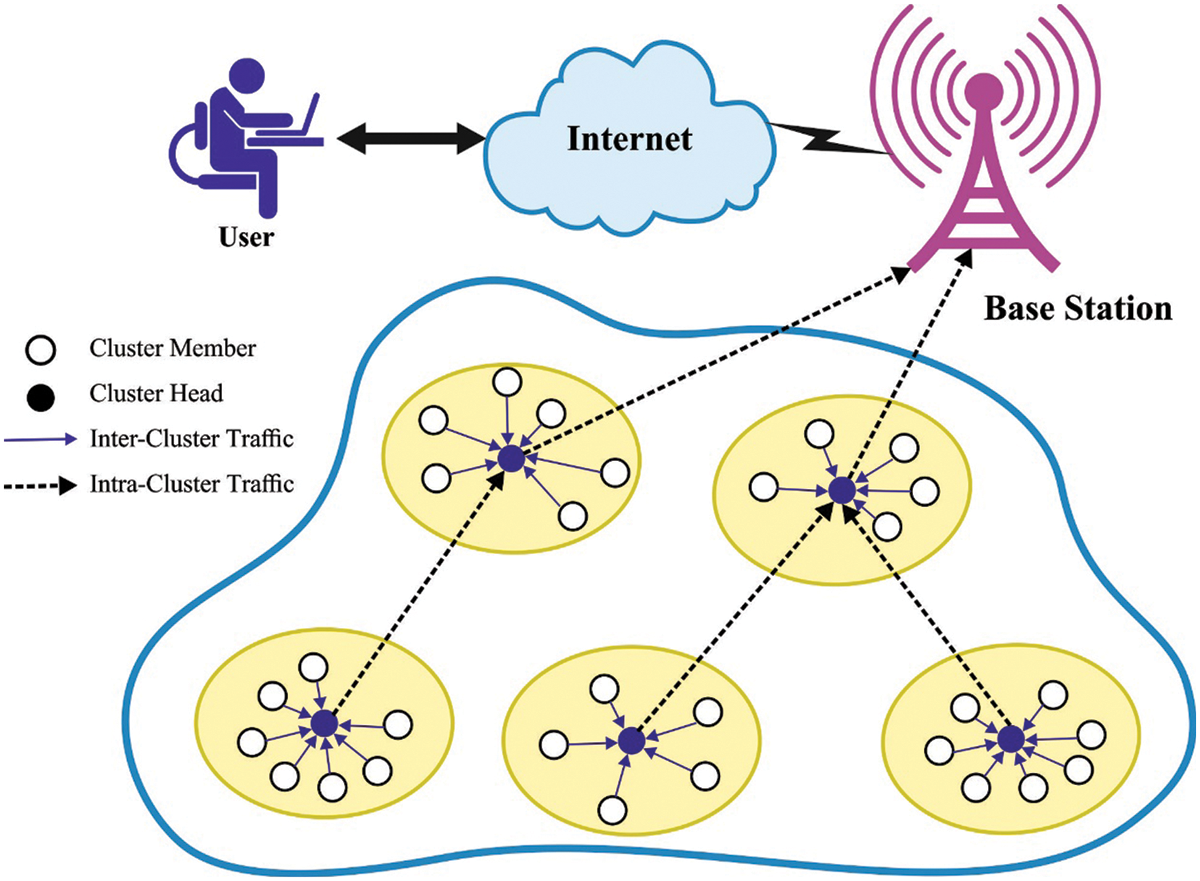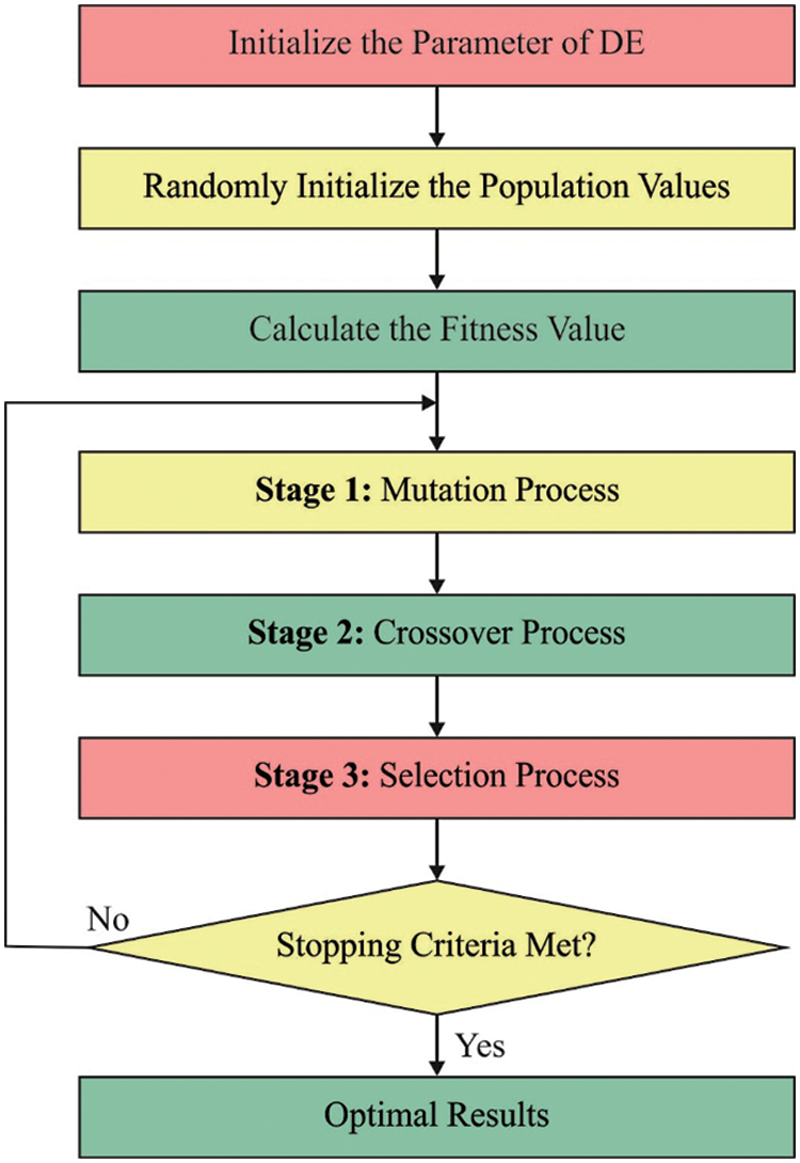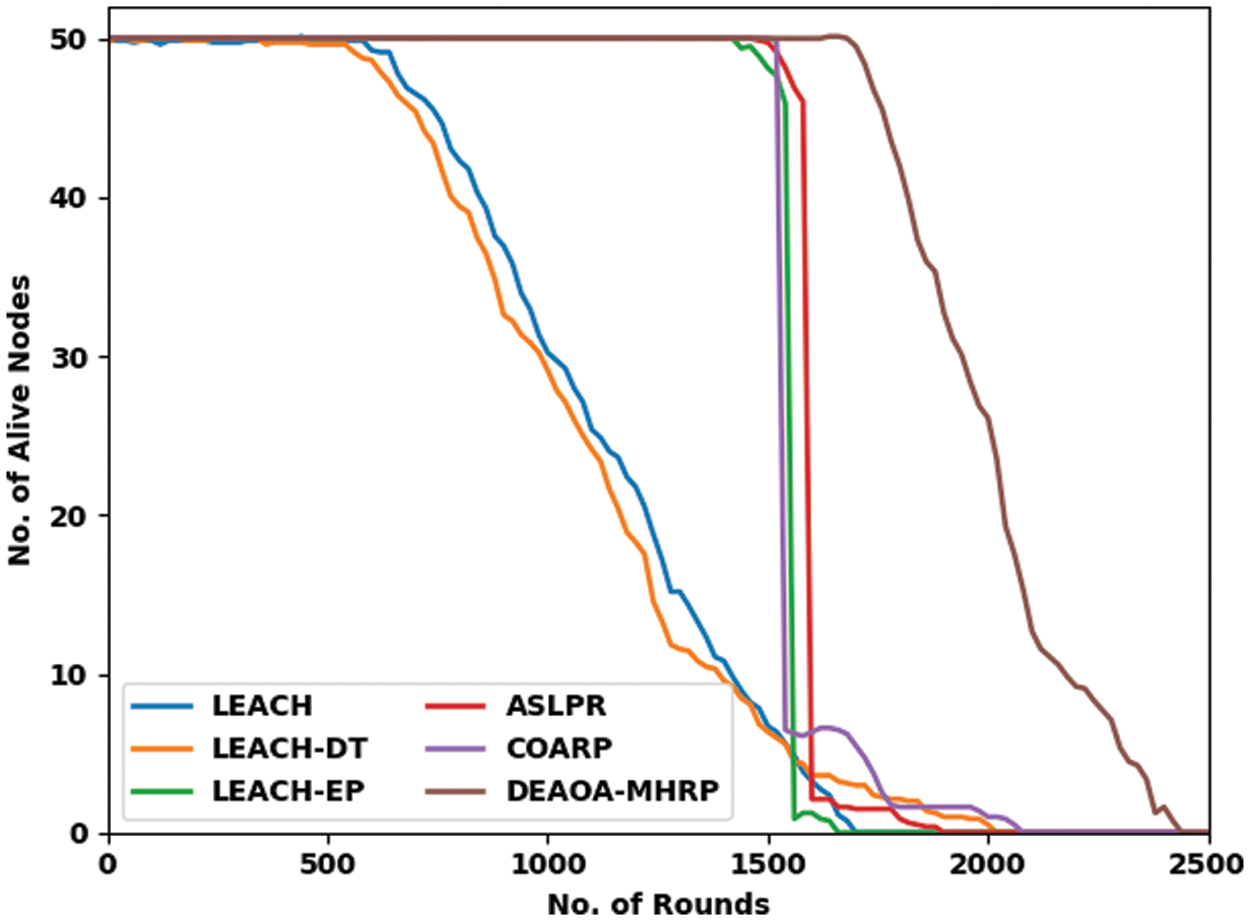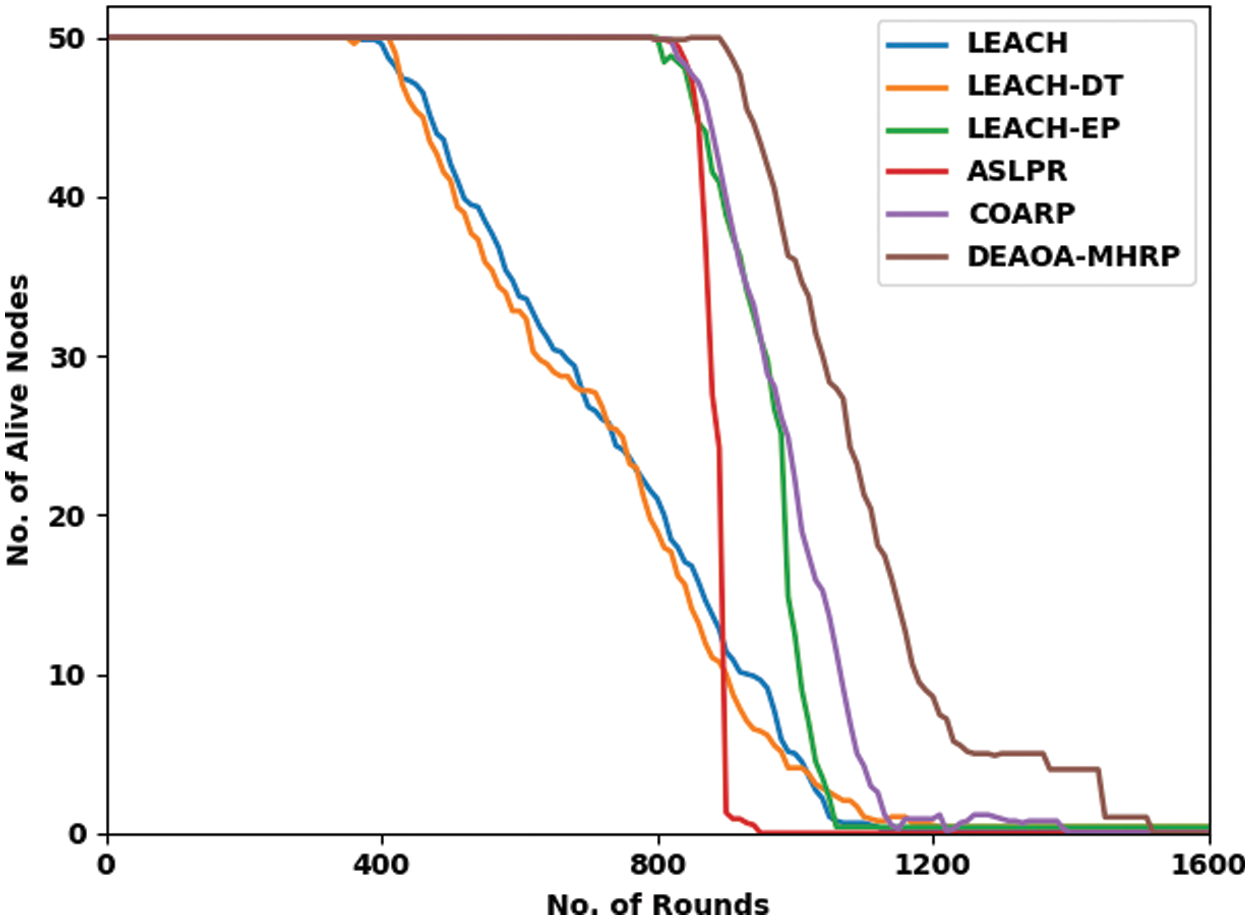 Open Access
Open Access
ARTICLE
Differential Evolution with Arithmetic Optimization Algorithm Enabled Multi-Hop Routing Protocol
1 Department of Computer and Self Development, Preparatory Year Deanship, Prince Sattam bin Abdulaziz University, AlKharj, Saudi Arabia
2 Department of Information Systems, College of Computer and Information Sciences, Princess Nourah Bint Abdulrahman University, P.O. Box 84428, Riyadh, 11671, Saudi Arabia
3 Department of Computer Science, College of Science & Art at Mahayil, King Khalid University, Abha, 62529, Saudi Arabia
4 Department of Computer Science, College of Computing and Information System, Umm Al-Qura University, Saudi Arabia
5 Department of Computer Science, College of Sciences and Humanities- Aflaj, Prince Sattam bin Abdulaziz University, Saudi Arabia
6 Department of Electrical Engineering, Faculty of Engineering and Technology, Future University in Egypt, New Cairo, 11845, Egypt
* Corresponding Author: Manar Ahmed Hamza. Email:
Computer Systems Science and Engineering 2023, 45(2), 1759-1773. https://doi.org/10.32604/csse.2023.030581
Received 29 March 2022; Accepted 09 June 2022; Issue published 03 November 2022
Abstract
Wireless Sensor Networks (WSN) has evolved into a key technology for ubiquitous living and the domain of interest has remained active in research owing to its extensive range of applications. In spite of this, it is challenging to design energy-efficient WSN. The routing approaches are leveraged to reduce the utilization of energy and prolonging the lifespan of network. In order to solve the restricted energy problem, it is essential to reduce the energy utilization of data, transmitted from the routing protocol and improve network development. In this background, the current study proposes a novel Differential Evolution with Arithmetic Optimization Algorithm Enabled Multi-hop Routing Protocol (DEAOA-MHRP) for WSN. The aim of the proposed DEAOA-MHRP model is select the optimal routes to reach the destination in WSN. To accomplish this, DEAOA-MHRP model initially integrates the concepts of Different Evolution (DE) and Arithmetic Optimization Algorithms (AOA) to improve convergence rate and solution quality. Besides, the inclusion of DE in traditional AOA helps in overcoming local optima problems. In addition, the proposed DEAOA-MRP technique derives a fitness function comprising two input variables such as residual energy and distance. In order to ensure the energy efficient performance of DEAOA-MHRP model, a detailed comparative study was conducted and the results established its superior performance over recent approaches.Keywords
In recent years, there has been an increasing tendency towards Wireless Sensor Network (WSN) due to its substantial usage in some fields [1], for example, civilian, industrial, and military. WSN is a non-architectural system that comprises of a collection of independent Sensor Nodes (SN) that are used for monitoring and detecting a field. SNs congregate to build a wireless system which is randomly deployed in a geographical region for observation. All the SNs detect specific information and transfer it to the Base Station (BS) via SN through wireless transmission. All the nodes in WSN have four major components in which the processing unit comprises of a routing, processor, and storage protocol [2]. This unit implements the communication protocol that allows the transmission of data among nodes; sensing unit includes more than one sensor node for information attainment from the situation. Later, Analogue to Digital Converter (ADC) transforms the analogue signals, generated through sensor nodes according to the observed phenomenon, to arithmetical signal; power unit (usually, battery) is the distinctive source of energy that delivery energy to each unit in SN [3]; wireless communication unit includes two radio frequency models i.e., reception and emission, which ensures a wireless transmission for connecting the node to the system. Fig. 1 illustrates the structure of WSN [4].

Figure 1: Structure of WSN
WSN is a network established by a collection of arbitrarily-positioned micro-sensors in a particular region, and in any case, it happens to be a single sink. In WSN, there exists dissimilar types of sensors such as BS, source sensors (normal sensor), and intermediate sensors (particularly Cluster-Head (CH) in clustered networks) [5]. These micro sensors can observe environmental and physical phenomena such as pollution, heartbeat, temperature, and so on. These sensors gather information and transmits them to the sink and later via internet, the client attains the data from sink. The primary objective of WSN is to measure the appropriated criterion, control a specific zone, and detect the occurrence of actions in a supervised region [6]. In WSN, the sensors are alimented through batteries (in each case, either they are replaceable or rechargeable).
Energy is expended when gathering information, treatment, and receiving or transmitting the packets. Consequently, energy utilization is the most important limitation in WSN [7]. Moreover, data redundancy is another constraint that decreases and negatively influences the energy efficacy of sensors. So, it is challenging to economize the energy to improve the lifetime of the network. In this aspect, various researches on WSN show the significance of routing protocol. Routing approach is a selection technique in which the accurate path is identified for the transmission of information from source to terminus [8]. The aim of routing protocol is to strengthen the data transfer process, energy efficient, and the scalability of network [9]. Recently, several routing methods have been introduced in WSN to expand the lifetime of network by minimizing power utilization. The presented method depends on various metrics such as network structure, topology, and communication model [10].
Clustering is an effectual method to balance energy in WSN through data collection. Clustering routing protocol is utilized in WSN to be energy-effective, since clustering technique helps in minimizing the amount of packets transmitted in the system. In WSN, clustering has multiple benefits such as less load, more scalability, data aggregation, lesser energy utilization, load balancing, collision avoidance, fault-tolerance, mitigation of latency, assured connectivity, maximized network lifespan, high robustness, and so on. The authors [11] presented a Fault-tolerant cluster-based routing method for WSN with a hybrid model named FAGWO-H that integrates Grey Wolf Optimization (GWO) and Firefly Optimization (FA). FA is applied to achieve optimum clustering whereas GWO selects the optimal route between BSs and the CHs. The presented technique employs two fitness functions for GWO and FA. In literature [12], ‘sink mobility-based data transmission and ‘CH selection’ are enhanced through a hybrid model in which Genetic Algorithm (GA) and Particle Swarm Optimization (PSO) approaches are considered respectively for all the tasks. The strong performance of GA assists in selecting CHs, while PSO helps in identifying the optimal path for sink mobility.
The authors in [13] introduced a Robust Cluster Based Routing Protocol (RCBRP) to distinguish the routing path, while lesser energy is used for enhancing network lifespan. The proposed system has six stages to examine the ‘ow and transmission’. There are two approaches presented in this study such as i) energy-effective routing and clustering method and ii) distance and energy utilization method. The network uses lower energy and balances the load through clustering the intelligent devices. The study conducted earlier [14] presented an approach called Energy-effective Cluster-based Routing Protocol with Unequal Clustering and improved Ant Colony Optimization (ACO) approaches (ECRP-UCA). The presented method splits the network into unequal clusters, according to number of neighbor nodes, RE, distance to the sink, and a novel parameter termed ‘backward relay node’ in preceding the round to balance the load amongst CH selection in a suitable manner. In addition, an ACO-based routing model was developed for consistent and efficient intercluster routing from CH to the sink.
The authors in the literature [15] proposed an optimum CH for energy-effective routing protocol in WSN. Since the major contribution comes from CH selection, this study presented a new hybrid approach i.e., ACO-incorporated Glowworm Swarm Optimization (GSO) (ACI-GSO) method. In other terms, ACO and hybridization of GSO approaches was proposed in this study. The aim of CH selection is to minimize the distance amongst the carefully chosen CHs. This makes the fitness function easy to accomplish using various objectives such as energy, delay, and distance. In the study conducted earlier [16], an adoptive hierarchical-clustering-based routing method for EH-WSN (HCEH-UC) was proposed to accomplish continuous coverage of the targeted area via distributed alteration of data communication. First, a hierarchical clustering-based routing method was presented to balance the energy utilization of nodes. Next, a distributed adjustment of working mode was presented for adaptively controlling the count of nodes in energy harvesting mode that might result in uninterrupted target coverage.
The current study proposes a novel Differential Evolution with Arithmetic Optimization Algorithm Enabled Multi-hop Routing Protocol (DEAOA-MHRP) for WSN. The proposed DEAOA-MHRP model integrates the concepts of Different Evolution (DE) and Arithmetic Optimization Algorithm (AOA) to improve convergence rate and solution quality. Besides, the inclusion of DE in traditional AOA helps in overcoming the local optima problems. In addition, the proposed DEAOA-MRP technique derives a fitness function that comprises of two input variables such as residual energy and distance. In order to ensure an energy-efficient performance of the proposed DEAOA-MHRP model, a detailed comparative study was conducted.
Rest of the paper is organized as follows. Section 2 discusses about the proposed model and Section 3 validates the proposed model. Next, Section 4 concludes the paper.
2 The Proposed Routing Protocol
In this study, a novel DEAOA-MHRP model has been developed for optimum selection of the routes towards the destination in WSN. The proposed DEAOA-MHRP model integrates the concepts of DE and AOA to improve convergence rate and solution quality. Besides, the inclusion of DE in traditional AOA helps in overcoming the local optima problems.
AOA is a recently-developed metaheuristic algorithm that follows a simple structure and less computational complexity. Assume M and D operators help in producing large steps during the iterations, M and D are majorly performed at the time of exploration. It can be defined as follows [17]:
Here,
where as
In Eq. (1), it is obvious that both M and D functions are created in highly stochastic places for searching agents on the fundamentals of optimum place. Conversely, S and A operators are executed to emphasize the local exploitation, which is making lesser steps from searching space. The mathematical formulation is determined as follows.
An optimization technique’s superiority can be understood from its balancing between exploration as well as exploitation phases. In AOA, the parameter
Whereas

Fig. 2 showcases the flowchart of DE technique. At most of the times, DEAOA is established for developing original AOA convergence capability, qualified solutions, and the capability for avoiding local optimum problem [18]. Therefore, DE approach is established from convention AOA to procedural DEAOA. The presented DEAOA approach was established to perform ‘exploration searching’ by AOA and ‘exploitation searching’ by DE. It also generates an excellent balance amongst the searching approaches and guarantees which of the presented technique can avert the local optimum. DEAOA process starts with (1) Definition of parameter values of the utilized technique, (2) Creation of a candidate solution, (3) Determination of fitness function, (4) Selection of optimum solution, (5) when the provided state is true, AOA is implemented to update the solution; else, DE is implemented to update the solution, and (6) next, another state is provided either to stop or continue the optimized method.

Figure 2: Flowchart of DE
2.2 Application of DEAOA Technique for Routing Process
The proposed DEAOA-MRP technique derives a fitness function that comprises of two input variables such as residual energy and distance. To find the optimum set of routes, the dimension of each fish is found to be equivalent to CH and further location is positioned in BS. Assume,
The aim is to define the optimum set of routes from CH to destination through FF including two parameters such as energy and distance. Initially, the RE of the next-hop node is defined and the node with maximal energy is processed as ‘relay node’. It can be expressed as given herewith.
As well, Euclidean distance is employed to define the distance from CH to destination. The minimization of energy dissipation depends mainly on transmission distance. Hence, the next sub-objective, using distance is
The abovementioned sub-objective is described in FF in which
In this section, the performance validation of the proposed DEAOA-MHRP model was conducted under two scenarios based on the location of sink (Scenario 1-Sink Location 50 m, 50 m; Scenario 2-Sink Location 100 m, 100 m).
Tab. 1 and Fig. 3 demonstrate the detailed number of alive nodes (NOAN) analysis results achieved by DEAOA-MHRP model with recent models on scenario 1 [19]. From the results, it can be observed that Low Energy Adaptive Clustering Hierarchy (LEACH) and LEACH-DT models achieved low NOAN over other methods. Followed by, LEACH-Election Probability (EP) and Application Specific Low Power Routing (ASLPR) models demonstrated slightly improved NOAN values. Along with these, COARP model gained a reasonable NOAN. However, the results imply that the proposed DEAOA-MHRP model obtained the maximum NOAN under all rounds of execution. For instance, with 1,600 rounds, DEAOA-MHRP model offered a high NOAN of 50, whereas LEACH, LEACH-distance based threshold (DT), LEACH-EP, ASLPR, and COARP models obtained the leaset NOAN values such as 3, 4, 1, 2, and 6 respectively. Along with that, with 2400 rounds, the proposed DEAOA-MHRP model provided an enhanced NOAN of 2, whereas LEACH, LEACH-DT, LEACH-EP, ASLPR, and COARP models produced the least NOAN of 0, 0, 0, 0, and 0 respectively.


Figure 3: NOAN analysis results of DEAOA-MHRP technique on scenario 1
Tab. 2 and Fig. 4 illustrate a detailed Maximum Energy of Network (MEN) analysis results accomplished by DEAOA-MHRP method and other recent models on scenario 1. From the results, it can be inferred that LEACH and LEACH-DT models achieved low MEN over other methods. Followed by, LEACH-EP and ASLPR models demonstrated slightly improved MEN. Further, COARP approach gained a reasonable MEN. Afterward, the results imply that the proposed DEAOA-MHRP model obtained the maximum MEN under all rounds of execution. For instance, with 100 rounds, DEAOA-MHRP model obtained an increased MEN of 0.854 J, whereas LEACH, LEACH-DT, LEACH-EP, ASLPR, and COARP techniques obtained low MEN of 0.791 J, 0.774 J, 0.766 J, 0.801 J, and 0.839 J correspondingly. Also, with 500 rounds, the proposed DEAOA-MHRP method provided an enhanced MEN of 0.500 J, whereas LEACH, LEACH-DT, LEACH-EP, ASLPR, and COARP techniques resulted in minimal MEN values such as 0.103 J, 0.121 J, 0.221 J, 0.327 J, and 0.354 J correspondingly.


Figure 4: MEN analysis results of DEAOA-MHRP technique on scenario 1
Tab. 3 and Fig. 5 depict the detailed Total Number of data Packets received by Base Station (TNPBS) analysis results attained by the proposed DEAOA-MHRP system with recent techniques on scenario 1. The results infer that LEACH and LEACH-DT models achieved low TNPBS over other methods. Followed by, LEACH-EP and ASLPR approaches demonstrated slightly improved TNPBS. Along with that, COARP system has gained a reasonable TNPBS. However, the outcomes infer that the proposed DEAOA-MHRP technique obtained the maximal TNPBS under all rounds of execution. For instance, with 1000 rounds, the proposed DEAOA-MHRP model offered an increased TNPBS of 48960 whereas LEACH, LEACH-DT, LEACH-EP, ASLPR, and COARP models obtained less TNPBS values such as 47997, 47997, 48960, 48960, and 48960 correspondingly. Besides, with 1600 rounds, DEAOA-MHRP approach provided an enhanced TNPBS of 78470, whereas LEACH, LEACH-DT, LEACH-EP, ASLPR, and COARP techniques resulted in minimal TNPBS values such as 54011, 58803, 76093, 76741, and 71428 correspondingly.


Figure 5: TNPBS analysis results of DEAOA-MHRP technique on scenario 1
Tab. 4 and Fig. 6 showcase the detailed NOAN inspection results accomplished by DEAOA-MHRP model and other recent models under scenario 2. From the results, it can be inferred that LEACH and LEACH-DT models achieved low NOAN over other methods. Followed by, LEACH-EP and ASLPR models outperformed others with somewhat enhanced NOAN. Besides, COARP model has gained a reasonable NOAN. However, the outcomes imply that the proposed DEAOA-MHRP model obtained the maximal NOAN under all rounds of execution. For instance, with 800 rounds, the proposed DEAOA-MHRP technique obtainable an enhanced NOAN of 50, whereas LEACH, LEACH-DT, LEACH-EP, ASLPR, and COARP techniques obtained low NOAN values such as 21, 19, 50, 50, and 50 correspondingly. Besides, with 1200 rounds, DEAOA-MHRP technique achieved a high NOAN of 9, whereas LEACH, LEACH-DT, LEACH-EP, ASLPR, and COARP methodologies produced minimal NOAN values such as 0, 1, 0, 0, and 1 correspondingly.


Figure 6: NOAN analysis results of DEAOA-MHRP technique on scenario 2
Tab. 5 and Fig. 7 portray the detailed MEN analysis results achieved by DEAOA-MHRP model and other recent techniques on scenario 2. The results infer that LEACH and LEACH-DT approaches achieved low MEN over other techniques. Then, LEACH-EP and ASLPR models demonstrated slightly improved MEN values. Moreover, COARP technique reached a reasonable MEN. However, the results infer that the proposed DEAOA-MHRP model obtained the maximum MEN under all rounds of execution. For instance, with 100 rounds, DEAOA-MHRP system obtained an increased MEN of 0.834 J, whereas LEACH, LEACH-DT, LEACH-EP, ASLPR, and COARP techniques reached low MEN values such as 0.829 J, 0.748 J, 0.790 J, 0.760 J, and 0.819 J correspondingly. In addition, with 500 rounds, the proposed DEAOA-MHRP model provided an enhanced MEN of 0.442 J, whereas LEACH, LEACH-DT, LEACH-EP, ASLPR, and COARP models resulted in low MEN values such as 0.175 J, 0.131 J, 0.291 J, 0.336 J, and 0.439 J respectively.


Figure 7: MEN analysis of DEAOA-MHRP technique on scenario 2
Tab. 6 and Fig. 8 show the detailed TNPBS analysis results achieved by DEAOA-MHRP model against recent models on scenario 2. Both LEACH and LEACH-DT models achieved low TNPBS over other methods. Followed by, LEACH-EP and ASLPR models demonstrated slightly improved TNPBS values. Besides, COARP approach reached a reasonable TNPBS. But, the results denote that the proposed DEAOA-MHRP model obtained the maximum TNPBS values under all rounds of execution. For instance, with 200 rounds, the proposed DEAOA-MHRP model offered an enhanced TNPBS of 6560, whereas LEACH, LEACH-DT, LEACH-EP, ASLPR, and COARP techniques obtained lesser TNPBS values such as 6560, 6560, 6560, 6560, and 6560 respectively. Moreover, with 1200 rounds, the proposed DEAOA-MHRP model offered a high TNPBS of 45244, whereas LEACH, LEACH-DT, LEACH-EP, ASLPR, and COARP techniques produced lesser TNPBS values such as 33438, 36230, 41612, 43319, and 44107 correspondingly.


Figure 8: TNPBS analysis results of DEAOA-MHRP technique on scenario 2
In this study, a novel DEAOA-MHRP model has been developed for optimum selection of routes to reach the destinations in WSN. The proposed DEAOA-MHRP model integrates the concepts of DE and AOA to improve convergence rate and the quality of solution. Besides, the inclusion of DE in traditional AOA helps in overcoming the local optima problems. In addition, DEAOA-MRP technique derives a fitness function that comprises of two input variables such as residual energy and distance. In order to validate the energy-efficient performance of DEAOA-MHRP model, a detailed comparative study was conducted and the results confirmed the better performance of the proposed method over recent approaches. Thus, DEAOA-MHRP model can be employed to effectually determine the routes in WSN. In future, data aggregation approaches can be developed to further boost the energy efficiency in WSN.
Funding Statement: The authors extend their appreciation to the Deanship of Scientific Research at King Khalid University for funding this work under grant number (RGP 2/142/43). Princess Nourah bint Abdulrahman University Researchers Supporting Project number (PNURSP2022R237), Princess Nourah bint Abdulrahman University, Riyadh, Saudi Arabia. The authors would like to thank the Deanship of Scientific Research at Umm Al-Qura University for supporting this work by Grant Code: (22UQU4310373DSR14).
Conflicts of Interest: The authors declare that they have no conflicts of interest to report regarding the present study.
References
1. S. Arjunan and P. Sujatha, “Lifetime maximization of wireless sensor network using fuzzy based unequal clustering and ACO based routing hybrid protocol,” Applied Intelligence, vol. 48, no. 8, pp. 2229–2246, 2018. [Google Scholar]
2. S. Famila, A. Jawahar, A. Sariga and K. Shankar, “Improved artificial bee colony optimization based clustering algorithm for SMART sensor environments,” Peer-to-Peer Networking and Applications, vol. 13, no. 4, pp. 1071–1079, 2020. [Google Scholar]
3. S. Arjunan and S. Pothula, “A survey on unequal clustering protocols in wireless sensor networks,” Journal of King Saud University - Computer and Information Sciences, vol. 31, no. 3, pp. 304–317, 2019. [Google Scholar]
4. H. Liang, S. Yang, L. Li and J. Gao, “Research on routing optimization of WSNs based on improved LEACH protocol,” EURASIP Journal on Wireless Communications and Networking, vol. 2019, no. 1, pp. 194, 2019. [Google Scholar]
5. S. Arjunan, S. Pothula and D. Ponnurangam, “F5 N-based unequal clustering protocol (F5NUCP) for wireless sensor networks,” International Journal of Communication Systems, vol. 31, no. 17, pp. e3811, 2018. [Google Scholar]
6. A. A. Kamble and B. M. Patil, “Systematic analysis and review of path optimization techniques in WSN with mobile sink,” Computer Science Review, vol. 41, pp. 100412, 2021. [Google Scholar]
7. L. Y. Yuan and F. L. Lin, “Collection tree-oriented mesh routing optimization for extending the lifetime of wireless sensor networks,” International Journal of Distributed Sensor Networks, vol. 18, no. 3, pp. 155013292210854, 2022. [Google Scholar]
8. X. Xiao and M. Zhao, “Routing optimization strategy of IoT awareness layer based on improved cat swarm algorithm,” Neural Computing and Applications, vol. 34, no. 5, pp. 3311–3322, 2022. [Google Scholar]
9. Z. Xue, “Routing optimization of sensor nodes in the internet of things based on genetic algorithm,” IEEE Sensors Journal, vol. 21, no. 22, pp. 25142–25150, 2021. [Google Scholar]
10. M. Hajiee, M. Fartash and N. O. Eraghi, “Trust-based routing optimization using multi-ant colonies in wireless sensor network,” China Communications, vol. 18, no. 11, pp. 155–167, 2021. [Google Scholar]
11. K. Jaiswal and V. Anand, “FAGWO-H: A hybrid method towards fault-tolerant cluster-based routing in wireless sensor network for IoT applications,” The Journal of Supercomputing, 2022, https://doi.org/10.1007/s11227-022-04333-6. [Google Scholar]
12. B. M. Sahoo, H. M. Pandey and T. Amgoth, “GAPSO-H: A hybrid approach towards optimizing the cluster based routing in wireless sensor network,” Swarm and Evolutionary Computation, vol. 60, pp. 100772, 2021. [Google Scholar]
13. M. Shafiq, H. Ashraf, A. Ullah, M. Masud, M. Azeem et al. “Robust cluster-based routing protocol for iot-assisted smart devices in wsn,” Computers, Materials & Continua, vol. 67, no. 3, pp. 3505–3521, 2021. [Google Scholar]
14. N. Moussa and A. E. B. E. Alaoui, “An energy-efficient cluster-based routing protocol using unequal clustering and improved ACO techniques for WSNs,” Peer-to-Peer Networking and Applications, vol. 14, no. 3, pp. 1334–1347, 2021. [Google Scholar]
15. D. L. Reddy, C. Puttamadappa and H. N. Suresh, “Merged glowworm swarm with ant colony optimization for energy efficient clustering and routing in wireless sensor network,” Pervasive and Mobile Computing, vol. 71, pp. 101338, 2021. [Google Scholar]
16. B. Han, F. Ran, J. Li, L. Yan, H. Shen et al. “A novel adaptive cluster based routing protocol for energy-harvesting wireless sensor networks,” Sensors, vol. 22, no. 4, pp. 1564, 2022. [Google Scholar]
17. L. Abualigah, A. Diabat, S. Mirjalili, M. A. Elaziz and A. H. Gandomi, “The arithmetic optimization algorithm,” Computer Methods in Applied Mechanics and Engineering, vol. 376, pp. 113609, 2021. [Google Scholar]
18. L. Abualigah, A. Diabat, P. Sumari and A. Gandomi, “A novel evolutionary arithmetic optimization algorithm for multilevel thresholding segmentation of covid-19 ct images,” Processes, vol. 9, no. 7, pp. 1155, 2021. [Google Scholar]
19. M. Khabiri and A. Ghaffari, “Energy-aware clustering-based routing in wireless sensor networks using cuckoo optimization algorithm,” Wireless Personal Communications, vol. 98, no. 3, pp. 2473–2495, 2017. [Google Scholar]
Cite This Article
 Copyright © 2023 The Author(s). Published by Tech Science Press.
Copyright © 2023 The Author(s). Published by Tech Science Press.This work is licensed under a Creative Commons Attribution 4.0 International License , which permits unrestricted use, distribution, and reproduction in any medium, provided the original work is properly cited.


 Submit a Paper
Submit a Paper Propose a Special lssue
Propose a Special lssue View Full Text
View Full Text Download PDF
Download PDF Downloads
Downloads
 Citation Tools
Citation Tools